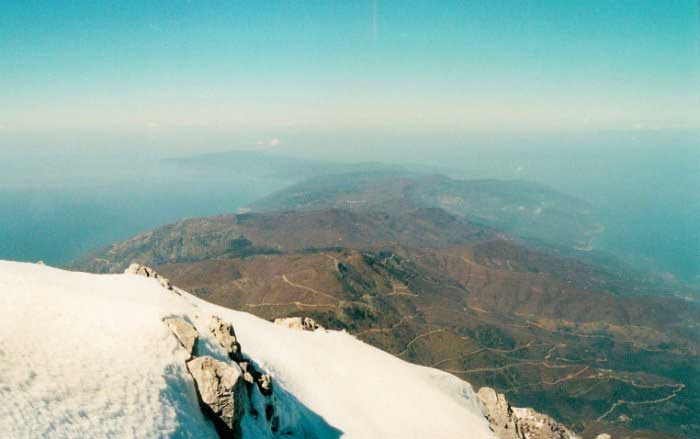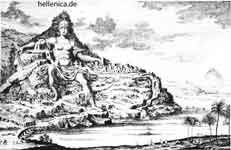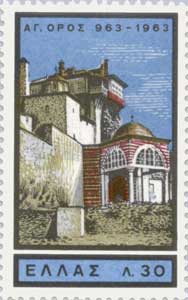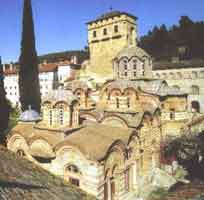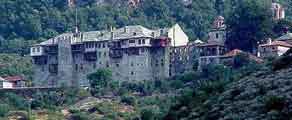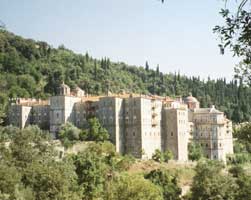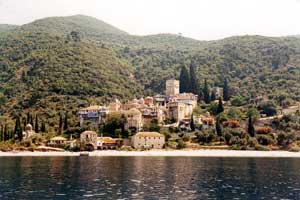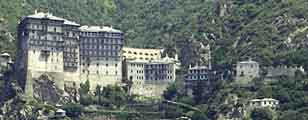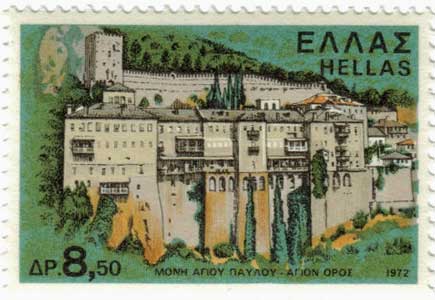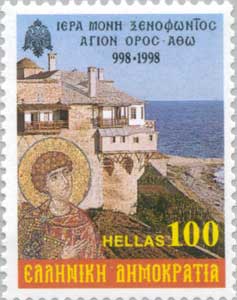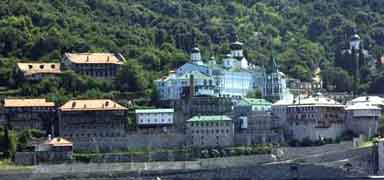.
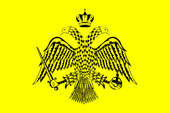
Flag of Mount Athos (Orthodox Church Flag) |
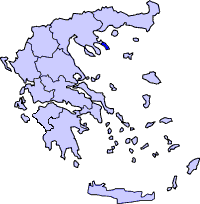 |
 |
The Athos peninsula as seen from the summit of Mount Athos (40°9′28″N, 24°19′36″E), looking north-west
Mount Athos is a mountain and a peninsula in Macedonia, northern Greece, called Άγιο Όρος (Ayion Oros or "Holy Mountain") in Modern Greek, or Ἅγιον Ὄρος (Hagion Oros) in Classical Greek. It is home to 20 Eastern Orthodox monasteries and forms an autonomous state under Greek sovereignty. Only monks are allowed to live on Athos and the current population numbers around 1,400. The peninsula, the easternmost "leg" of the larger Chalkidiki peninsula, protrudes into the Aegean Sea for some 60 km at a width between 7 to 12 km and covers an area of about 390 km², with the actual Mount Athos and its steep, densely forested slopes reaching up to 2,033 m.
The seas around the end of the peninsula can be dangerous. Xerxes I had a channel excavated across the isthmus to allow the passage of his invasion fleet in 483 BC.
Mythology
In Greek mythology, Athos, one of the Gigantes, threw a mountain at Zeus, who knocked it to the ground near Macedonia. This mountain was the holy peak of Mount Athos.
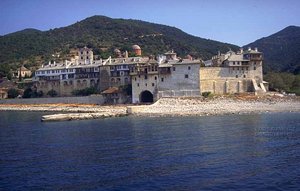
Xenophontos, one of the 20 monasteries on Mount Athos (Source)
History
An ancient story claims the Blessed Virgin Mary was sailing accompanied by St John the Evangelist on her way from Joppa to Cyprus to visit Lazarus. When the ship was blown off course to then pagan Athos it was forced to drop anchor near the port of Klement, close to the present monastery of Iviron. The Virgin walked ashore and, overwhelmed by the wonderful and wild natural beauty of the mountain, she blessed it and asked her Son for it to be her garden. A voice was heard; "let this place be your inheritance and your garden, a paradise and a haven of salvation for those seeking to be saved". Since that moment the mountain was consecrated as the garden of the Mother of God and was out of bounds to all other women.
Mount Athos as a monastic community was formally founded in 963, when the monk Athanasios established the monastery of Great Lavra, still the largest and most prominent of the 20 monasteries. It enjoyed the protection of the emperors of the Byzantine Empire during the following centuries and its wealth and possessions grew considerably. The Fourth Crusade in the 13th century brought new Roman Catholic overlords which forced the monks to seek protection from Pope Innocent III, until the restoration of the Byzantine Empire. It was raided by Catalan mercenaries in the 14th century, a century that also saw the theological conflict over the hesychasm practised on Mount Athos and defended by Gregory Palamas.
The Byzantine Empire collapsed in the 15th century and the newly established Islamic Ottoman Empire took over. They heavily taxed the monasteries, but for the most part left them alone. The population of monks and their wealth declined over the next centuries, but was revitalised around the 19th century by the donations and new arrivals from other Eastern Orthodox countries, such as Russia, Bulgaria, Romania and Serbia and each country came to exert its influence on individual monasteries. In 1912, during the First Balkan War, the Ottomans were forced out and after a brief conflict between Greece and Russia over sovereignty, the peninsula formally came under Greek sovereignty after World War I.
Politically the peninsula is mostly self-governed and consists of 20 main monasteries (which constitute the Holy Community to administer the territory) and the capital city and administrative centre, Karyes, also home to a governor as the representative of the Greek state. Spiritually, Mount Athos comes under the direct jurisdiction of the Ecumenical Patriarchate. Beyond the monasteries there are 12 sketae, smaller communities of monks, as well as many (solitary) hermitages throughout the peninsula. All persons leading a monastic life thereon acquire Greek citizenship without further formalities, upon admission as novices or monks. Visits to the peninsula are possible for laymen, but they need special permission.
In order to reduce sexual temptation, women are completely barred from the peninsula, a fact which has earned a certain amount of fame; even female domestic animals (with the exception, some say, of cats, as well as chickens which lay eggs that provide the fresh egg yolk needed for the paint used in iconography) are forbidden. However, during the Greek Civil War, Athos did shelter refugees including women and girls.[1] (http://www.straightdope.com/columns/010209.html)
In modern times, the Mount Athos monasteries have repeatedly been struck by wildfires, e.g. in August 1990, and in March 2004, fire gutted a large section of the Serbian monastary, Helandari. Due to the secluded locations of the monasteries, often atop small hills, as well as the unavailability of suitable fire fighting gear, the damages inflicted by these fires are often considerable.
Spiritually, Mount Athos is under the Patriarchate of Constantinople and is therefore in communion with all the monasteries on Mount Athos and with the Orthodox Church based in various countries. One monastery has recently broken away and has formed a completely independent schism on the Holy Mountain -- Esphygmenou Monastery. Esphygmenou is composed of 117 Zealot monks who stubbornly oppose the head of the Church and do not commemorate him any more. They believe that they are the last remaining true Christians in the world and that Orthodoxy has been corrupted by having dialogue with other faiths. They also object to the lifting of the anathemas against the Roman Catholic Church in the 1960's by Patriarch Athenagoras.
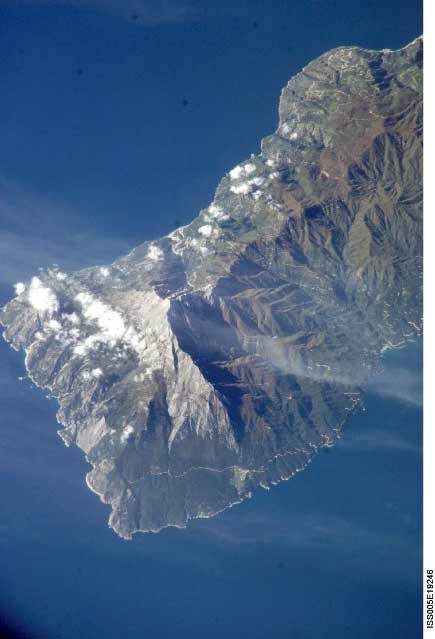
Ayion Oros, Cape Pinnea, Image Science and Analysis Laboratory, NASA-Johnson Space Center. 2 Nov. 2004. "Astronaut Photography of Earth - Quick View." (31 Dec. 2005).
Languages
Greek is commonly used in all Greek monasteries, but in some monasteries there are other languages in use, in St Panteleimonos Russian (35 monks), in Iviron Georgian (53 monks), in Chilandari Serbian (46), in Zographou Bulgarian (15), and in the sketae of Prodromos and Lacu Romanian (64). Today, many of the Greek monks are better educated and can speak English.
Contemplated postage stamp issue
In the winter of 1915 - 1916 the allied forces were considering occupation of the holy mountain. In anticipation of this they prepared a set of stamps which were intended for issue on the 25 January 1916 for the use of the Governing body of the Monastic Republic.
These stamps were produced in sheets of 12, (3 rows of 4), on board the aircraft carrier HMS Ark Royal. Six values were produced with values ranging up to one shilling and all were printed in black but on various different paper types.
The design of these stamps consisted of a square border with the name MOUNT ATHOS at the bottom in English, the left in Russian and on the right in Greek. At the top was in inscribed THEOCRACY. The denomination appeared at each corner with the English in the lower corners, Greek in the top left and Russian in the top right. The inner section showed a double headed Byzantine eagle with the effigy of the Madonna and child in an oval on its breast.
These stamps have no official status but fall into the category of prepared for use but not issued.
Two points of interest arise with these stamps:
Firstly they are the only issue to bear the currency and alphabets of three different languages.
Secondly they are the only issue to be produced on a warship in a time of war.
Art Treasures
The Athonian monasteries possess huge deposits of invaluable medieval art treasures, including icons, liturgical vestments and objects (crosses, chalices), codices and other Christian texts, imperial chrysobulls, holy relics etc. Until recently no organized study and archiving was being carried out, but lately a European union-funded effort to catalogue, protect and restore them is under way.
Literature
The 6,000 Beards of Mount Athos- ISBN 0-85955-251-9 by Ralph H. Brewster. A guide to the peninsula, first published in 1935, detailing the landscape, monasteries, skites, and the life of the inhabitants, including customs and more not usually discussed.
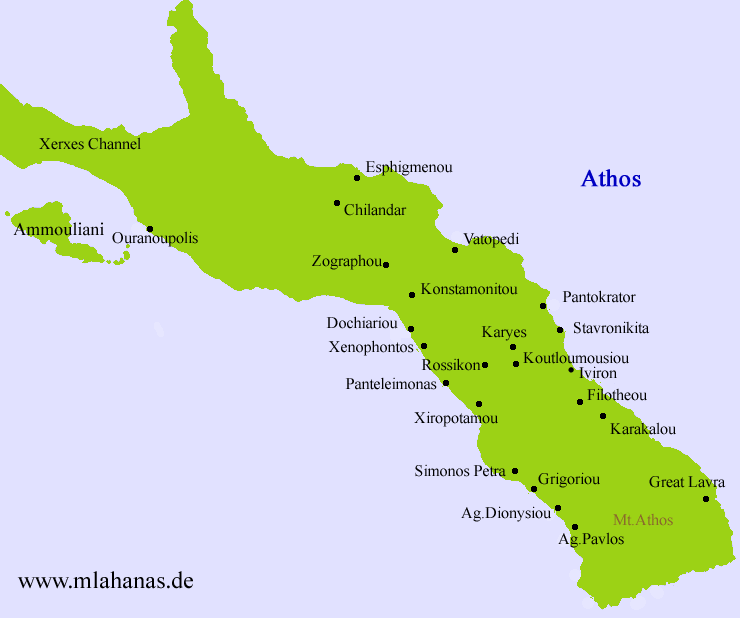
|
|
|||||||
| Monastery | 1903 | 1959 | 1968 | 1978 | 1988 | 1992 | 2000 |
| Great Lavra (Μονή Μεγίστης Λαύρας) | 1187 | 459 | 406 | 348 | 309 | 345 | 362 |
|
Monastery of Vatopedi |
966 | 129 | 83 | 60 | 55 | 75 | 142 |
| Iviron (Μονή Ιβήρων) | 456 | 101 | 68 | 52 | 53 | 61 | 78 |
| Chilandar (Μονή Χιλανδαρίου )
|
385 | 63 | 55 | 69 | 45 | 50 | 75 |

Dionysiou Monastery(Μονή Αγίου Διονυσίου) |
131 | 53 | 40 | 35 | 59 | 60 | 58 |
| Koutloumousiou (Μονή Κουτλουμουσίου) | 214 | 107 | 68 | 66 | 73 | 77 | 95 |
| Pantokrator (Μονή Παντοκράτορος) | 548 | 118 | 84 | 63 | 57 | 50 | 70 |
| Xiropotamos (Μονή Ξηροποτάμου)
Monastery Xiropotamos from Space |
106 | 43 | 36 | 22 | 38 | 34 | 40 |
| Zografou (Μονή Ζωγράφου)
|
155 | 21 | 15 | 13 | 11 | 11 | 20 |
| Dochiariou (Μονή Δοχειαρίου)
|
60 | 29 | 16 | 11 | 31 | 32 | 27 |
| Karakallou (Μονή Καρακάλλου ) | 130 | 42 | 30 | 13 | 16 | 26 | 37 |
| Filotheou (Μονή Φιλοθέου)
Monastery Filotheou from Space |
133 | 44 | 36 | 81 | 82 | 74 | 70 |
| Símonos Petras (Μονή Σίμωνος Πέτρας)
|
108 | 27 | 18 | 61 | 78 | 78 | 73 |
| Agios Pavlos (Μονή Αγίου Παύλου)
|
250 | 115 | 111 | 87 | 85 | 85 | 104 |
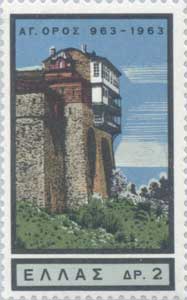
Stavronikita Monastery Stavronikita (Μονή Σταυρονικήτα) Monastery Stavronikita from Space |
219 | 35 | 26 | 43 | 40 | 33 | 45 |
| Xenofontos (Μονή Ξενοφώντος)
|
195 | 66 | 43 | 39 | 50 | 46 | 48 |
| Osios Grigorios (Μονή Γρηγορίου) | 105 | 53 | 34 | 57 | 72 | 77 | 86 |
| Esfigmenou (Μονή Εσφιγμένου) | 91 | 46 | 25 | 41 | 40 | 56 | 101 |
| Panteleimon (Μονή Αγίου Παντελεήμονος)
|
1928 | 61 | 27 | 30 | 32 | 40 | 53 |
| Konstamonitou (Μονή Κωνσταμονίτου) | 65 | 29 | 17 | 16 | 26 | 27 | 26 |
| Total | 7432 | 1641 | 1238 | 1217 | 1255 | 1337 | 1610 |
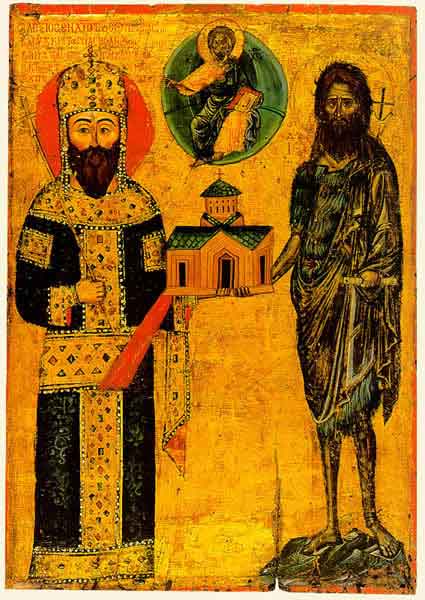
Alexius III of Trebizond, symbolic foundation of the Monastery Ag. Dionysiou of Athos
Stories
|
And hew out a huge mountain of pathos, |
The novelty of his appearance excited the attention of the people; and Alexander soon discovering, with astonishment, the object of their curiosity, ordered the crowd to make way for him, and demanded to know who he was. “A Macedonian architect,” replied Dinocrates, “who suggests schemes and designs worthy your royal renown. I propose to form Mount Athos into the statue of a man holding a spacious city in his left hand, and in his right a huge cup, into which shall be collected all the streams of the mountain, which shall then be poured into the sea.”
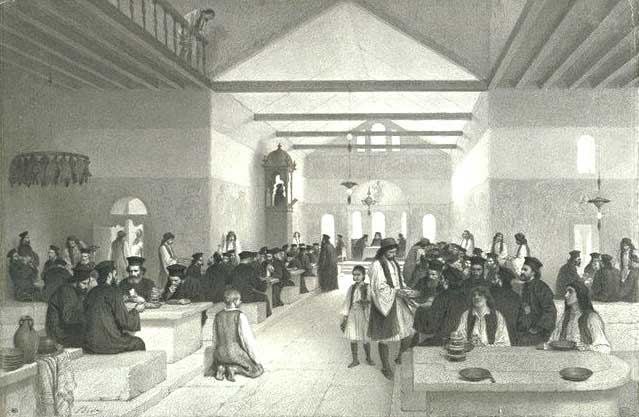
Ossios Grigorios Monastery, Alexander Bida
| Ancient Greece
Science, Technology , Medicine , Warfare, , Biographies , Life , Cities/Places/Maps , Arts , Literature , Philosophy ,Olympics, Mythology , History , Images Medieval Greece / Byzantine Empire Science, Technology, Arts, , Warfare , Literature, Biographies, Icons, History Modern Greece Cities, Islands, Regions, Fauna/Flora ,Biographies , History , Warfare, Science/Technology, Literature, Music , Arts , Film/Actors , Sport , Fashion --- |
Retrieved from "http://en.wikipedia.org/"
All text is available under the terms of the GNU Free Documentation License



